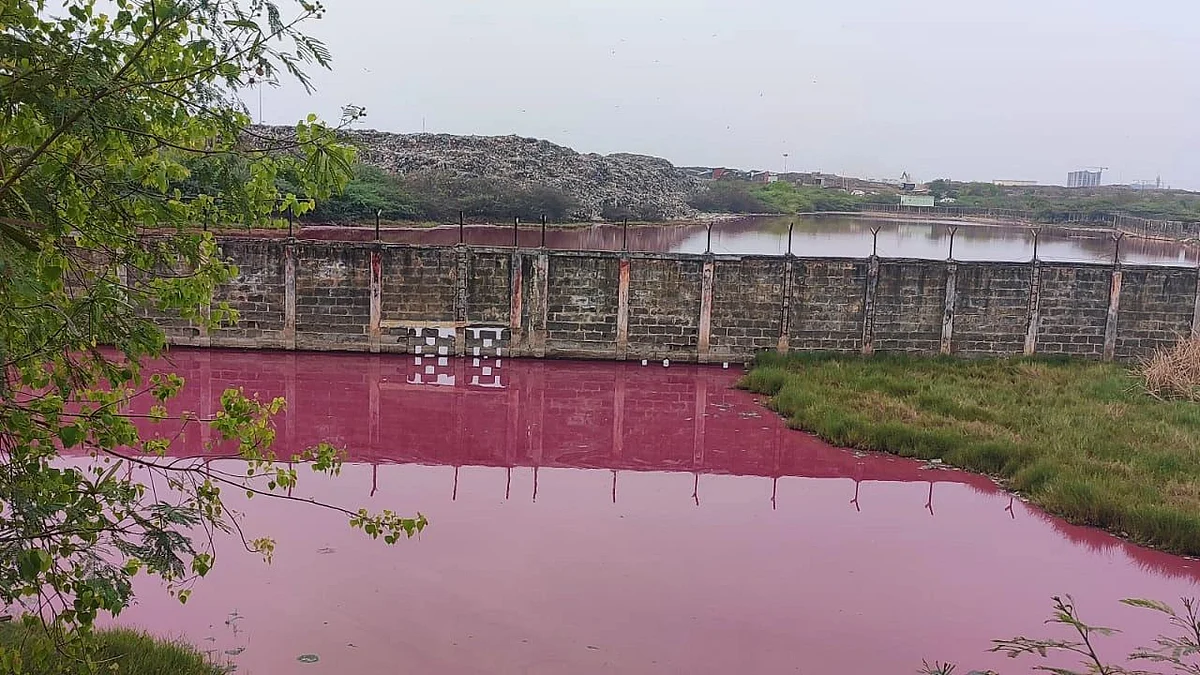Pollution: Why a Waterbody Turned Pink in Chennai's Pallikaranai Marshland
Experts claimed that algal bloom in the lake is due to the presence of the Perungudi dump yard nearby.

advertisement
In the first week of June 2022, a lake situated in the Pallikaranai marshland turned pink with no sign of birdlife, despite the area being known as a paradise for migratory birds during this time of the year.
Just a month back, a portion of the marshland caught fire and two months before that, the lake had turned pink for the first time.
Environmental experts claimed that algal bloom in the lake is due to the presence of the Perungudi dump yard nearby.
The Greater Chennai Corporation (GCC), the Tamil Nadu Pollution Control Board (TNPCB), the Forest Department, and Anna University have started monitoring the situation. Residents have demanded initiatives to prevent further pollution.
Increase in Toxic Chemicals Since January Noted
Presence of leachate with high biodegradable organics from the dumpsite may be the reason for the multiplication of the methanotrophs.
(Photo: The Quint)
Preliminary analysis has indicated the presence of methanotrophs, which includes bacteria and other single cell microorganisms.
“Leachate with high biodegradable organics from the dumpsite getting released into the waterbody may be the reason for the multiplication of the methanotrophs or methane oxidising bacteria. The pink colour of the waterbody is the result of the rapid multiplication of pigmented bacteria and algae. The reasons may include blooming of algal species belonging to the group of dinoflagellates, growth of halophilic archaea, distribution of methanotrophs, or the presence of purple sulphur bacteria,” the report by Anna University read.
Preliminary analysis has indicated the presence of methanotrophs, which includes bacteria and other single cell microorganisms.
(Photo: The Quint)
The colour appeared near Thoraipakkam Radial Road on the northern side. The southern side, which was handed over to the Forest Department by the Chennai civic body 10 years ago, has remained unaffected.
Officials of Tamil Nadu Pollution Control Board (TNPCB) and a team from IIT-Madras took samples from the lake on Thursday afternoon.
A researcher told The Quint that there has been a gradual increase of the total dissolved solids from January to April.
Perungudi Dump Yard Turning the Marshland Into a Cesspool
The Perungudi dump yard has violated solid waste management and environment rules.
(Photo: The Quint)
Meanwhile it is to be noted that on 27 April, a major fire broke out at Perungudi dump yard, which took several days to be put off. This was due to the dumping of all kinds of chemical, electronic, bio, and medical waste.
Environmentalists estimated a similar reason for the Pallikaranai lake turning pink. They claimed that as algal bloom thrives in methane, it is considered dangerous because it kills living organisms in the lake.
“The fire in dumpsite was expected since methane levels were high. The impact of the fire retardants on the water body was unexpected since the chemicals used was not known earlier. Fire retardant chemicals have released phosphorus and ammonia compounds causing algal blooms,” Professor Indumathi Nambi of IIT-M's Civil Engineering Department explained.
Fire retardant chemicals have released phosphorus and ammonia compounds causing algal blooms.
(Image: Sudharsun Jayaraj /Wikipedia)
A resident told The Quint, “The Corporation must strictly monitor the vehicles dumping garbage and polluted material at night. They claim sewage is treated before releasing but we are not sure. We are afraid how much this will contaminate the groundwater.”
The Perungudi dump yard, maintained by Greater Chennai Corporation and monitored by the Tamil Nadu Pollution Control Board has allegedly violated solid waste management and environment rules, according to a study by Anna University and independent researchers. Analysis of the samples have allegedly revealed high levels of heavy metals including chromium, cobalt, and sulphides.
Protecting Biodiversity Can Get TN Ramsar Status
Greater flamingoes used to frequent the Pallikaranai marshland.
(Image: Ashwin Bhat Kemthuru /Wikipedia)
Originally, the marshland ecosystem supports about 337 species of flora and fauna.
However, over 90 percent of the marshland that was spread across 6,000 hectares in 1960s has been lost as the marsh covers just 690 hectares today. The Comprehensive Management Plan for Pallikaranai Marsh 2014-19 prepared by Care Earth, pins the blame on construction of institutes like National Institute of Ocean Technology (NIOT) and Centre for Wind Energy Technology, and Perungudi dumpyard and sewage treatment plant, and development of IT corridors and residential complexes.
Recently, researchers from the Centre for Climate Change and Adaptation Research of Anna University, carried out a study which revealed that the wetland, which is supposed to act as a carbon sink, is emitting 18.4 gigatons of carbon dioxide and 8.4 gigatonnes of methane every year. Methane is a potent greenhouse gas and is a cause for major concern.
Over 90% of the marshland that was spread across 6,000 hectares in 1906s has been lost.
(Image: Sudharsun Jayaraj /Wikipedia)
"Scientific disposal of solid waste with recovery of materials and sanitary landfill will clean up the mess," Prof. Nambi of IIT-M told The Quint.
The Tamil Nadu government in November 2021 sent a proposal to the Union Government to declare Pallikaranai marshland as a Ramsar site to get the support of Green Climate Fund for eco-restoration and removal of invasive species. However, the wetland doesn't meet all the criteria to be declared a Ramsar site.